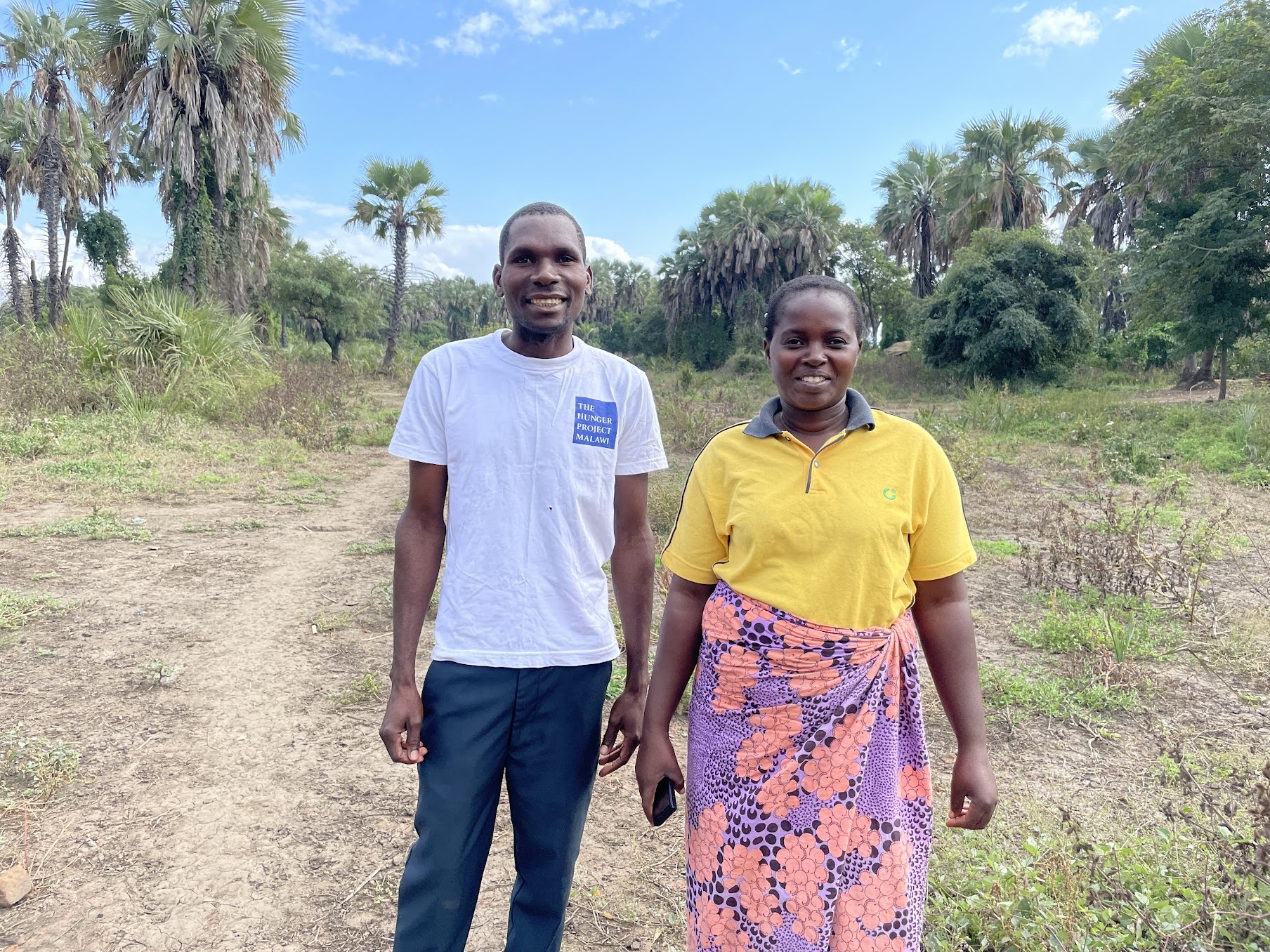
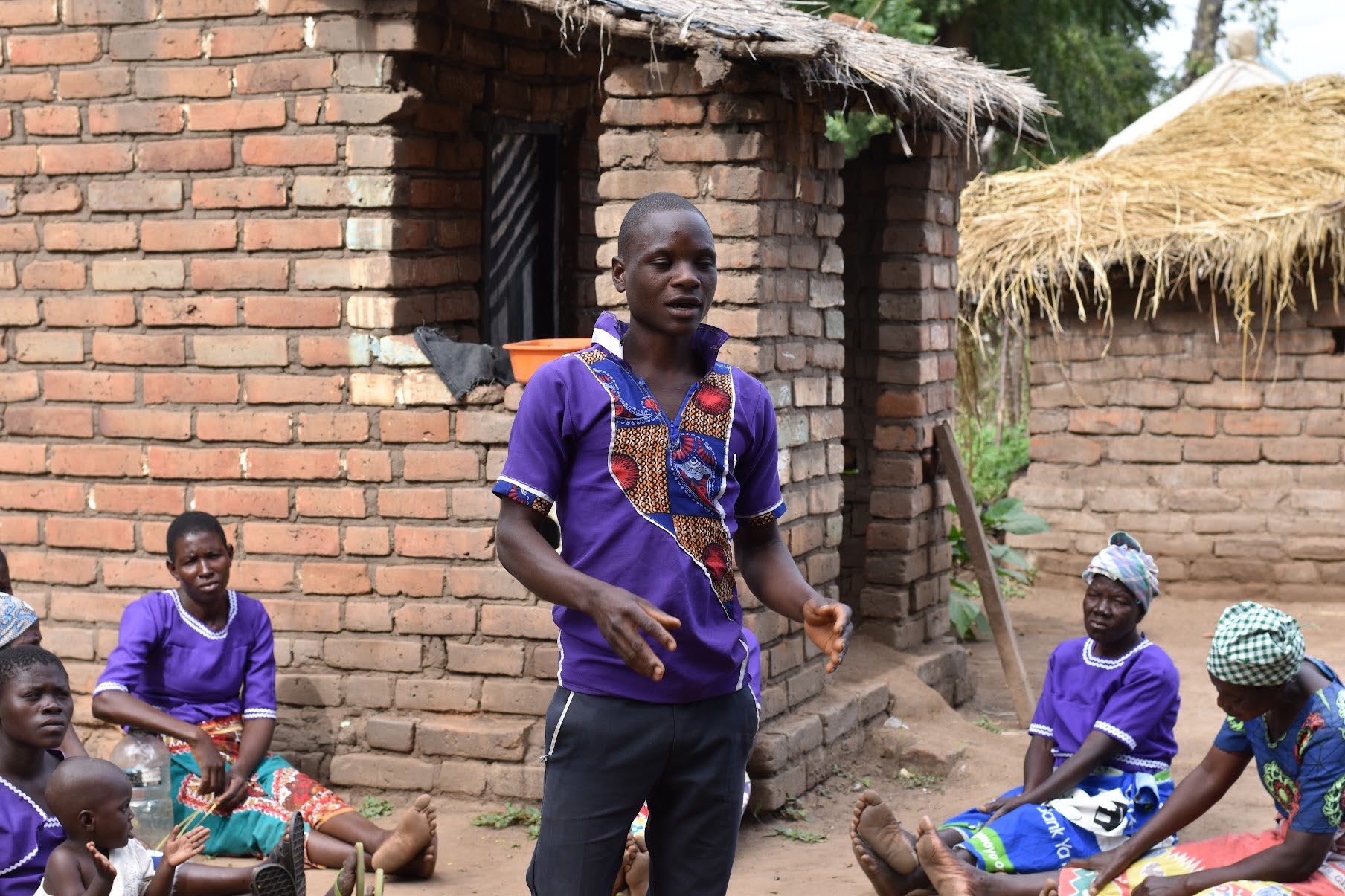
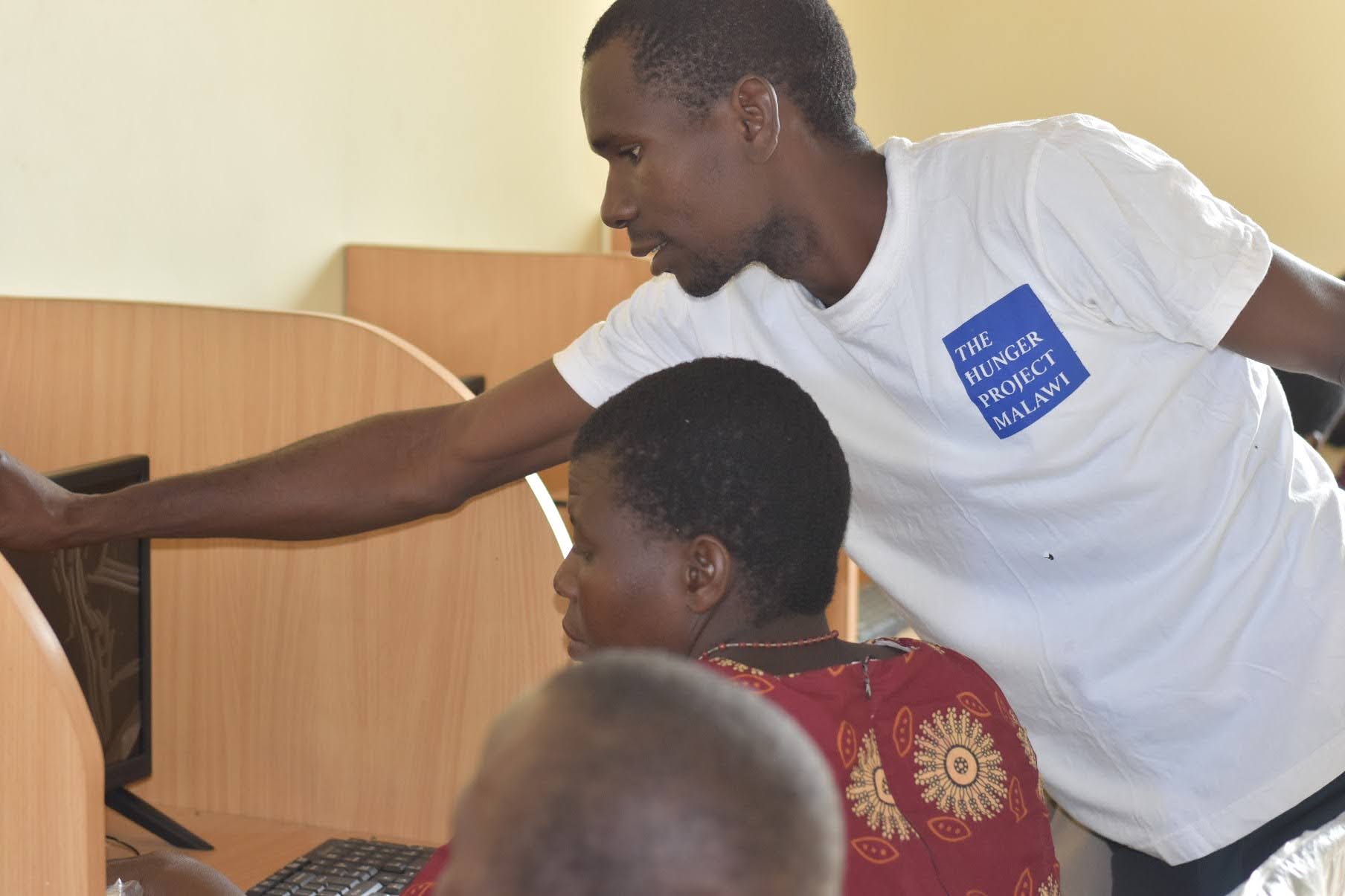
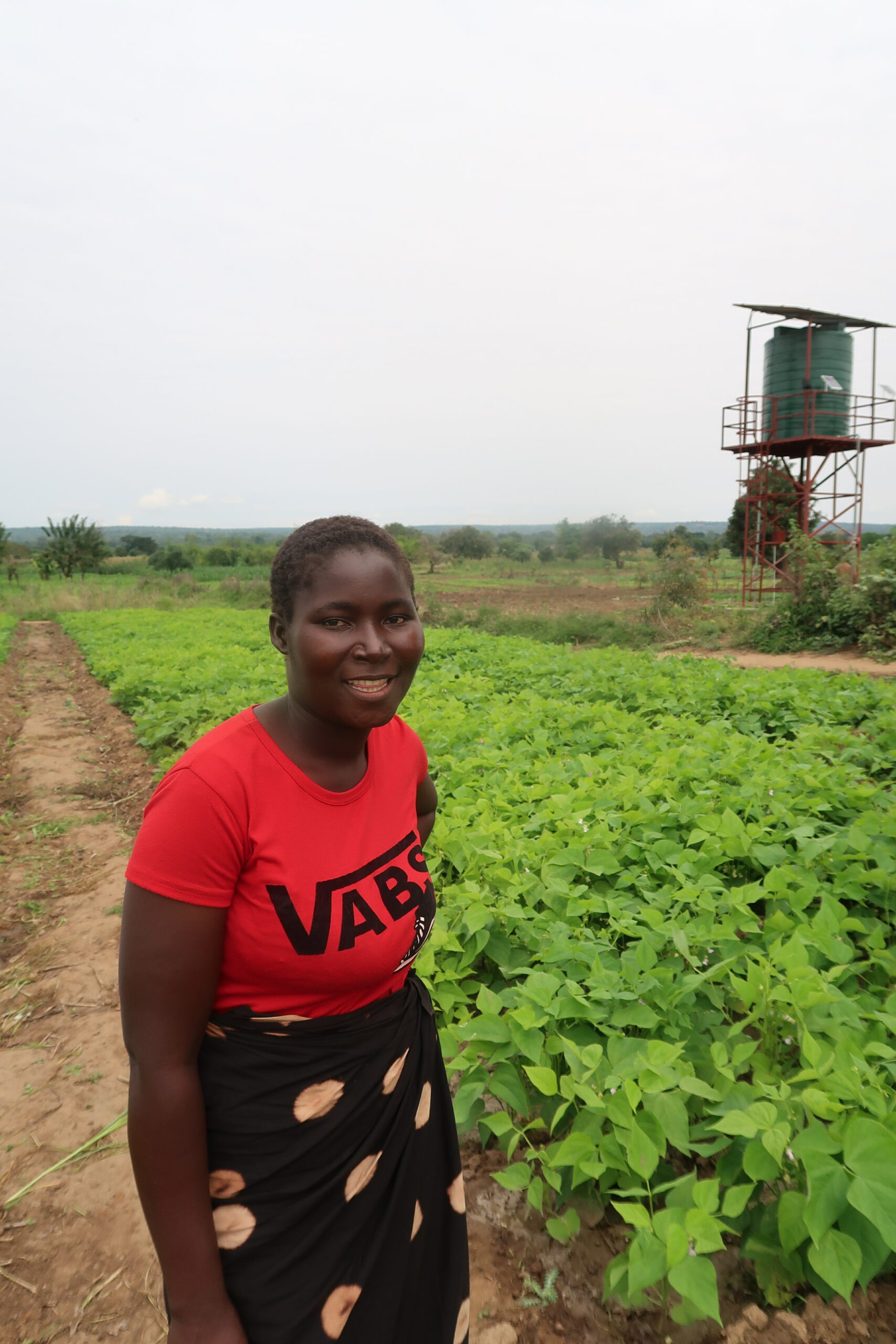
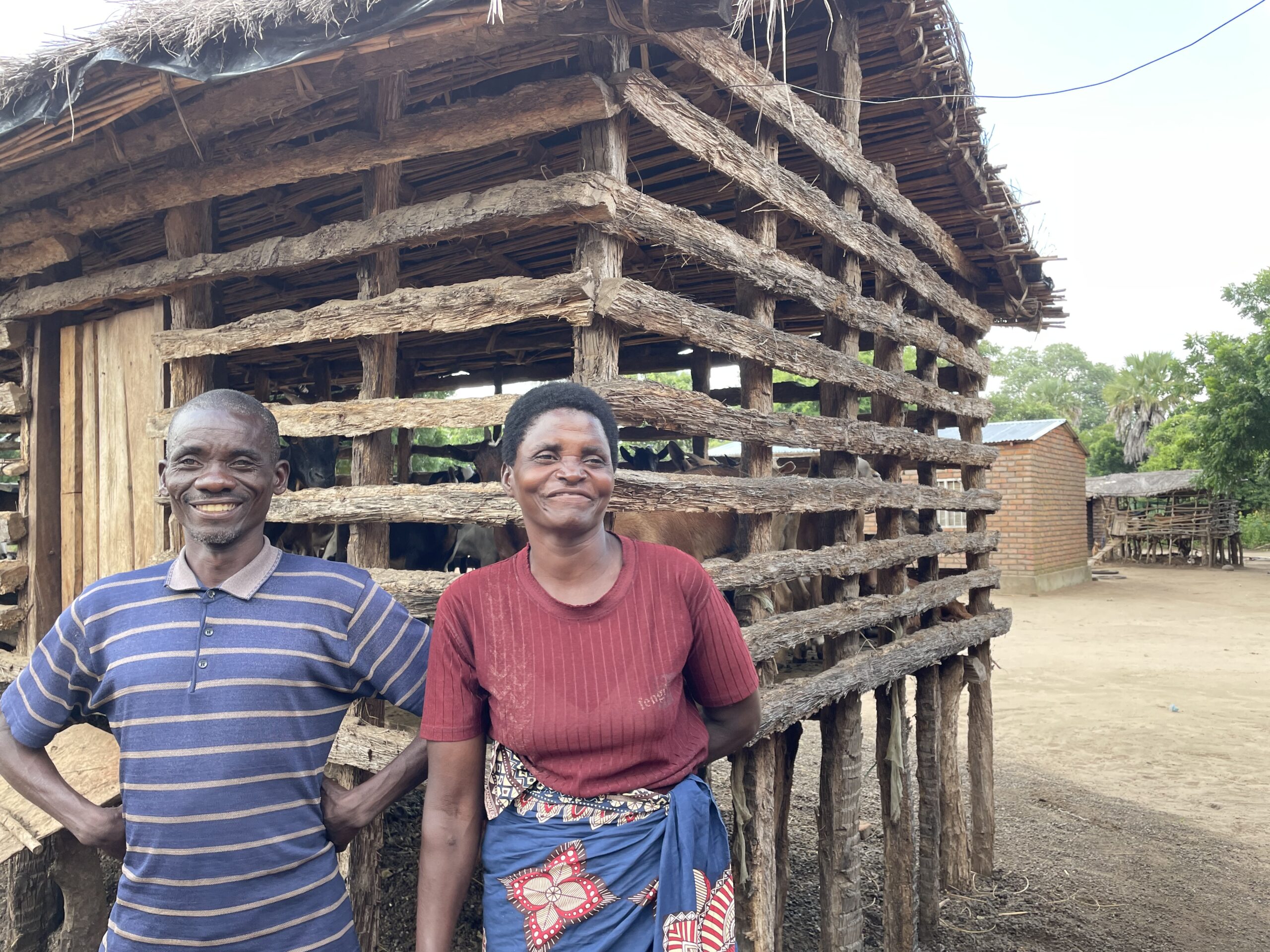
The Majete Reserve Project works with The Hunger Project using an area-based strategy that focuses on uplifting village meetings that inspire people to envision a shared goal for their community. The community lays out the actions they will take to achieve their goals. Local volunteers are recruited and trained in nine thematic areas that align with government interventions and the Sustainable Development Goals. Volunteers become local experts on a specific theme and pass on their knowledge during home-visits, village gatherings and by being a role model.
The Epicenter Strategy of The Hunger Project has three essential foundational pillars:
1. Empowering women as key agents of change
2. Mobilizing entire communities into self-reliance
3. Fostering effective partnerships that engage local governments
As a symbol of their self-reliance, the community builds a physical infrastructure that hosts a clinic, food bank, library/computer room, meeting hall, microfinance office, skills center, and demonstration garden. The primary resources for the epicenter strategy come from the people themselves and by making local government resources more effective. When the epicenter has achieved self-reliance, it no longer needs support from The Hunger Project. The community is ready to run itself.
Land management practice that intentionally integrates trees and shrubs into farming systems to derive environmental and economic benefits (greater crop yield, increased biodiversity, etc.); can include hedgerows, windbreaks, and silvopasture.
Farmer-to-farmer training emphasize agroforestry techniques such as the management of woodlots, forests, and gardens that promote tree crops for food, fiber, forage, shade, and wildlife habitat.
Trust
Third-Party Verification
Positive modifications to air quality achieved by controlling and reducing pollution levels, dust, particulate matter (PM) emissions, and by consistently monitoring overall quality.
The project has worked to mitigate the effects of charcoal burned for cooking to improve indoor and outdoor air quality by reducing particulate matter and greenhouse gas emissions.
Trust
Self-Reported
The protection and preservation of natural environments from damage or destruction to safeguard biodiversity and ecological resilience.
The project provides communities with educational materials and programs that emphasize natural resource conservation within the reserve and in the managed landscapes that surround it.
Trust
Third-Party Verification
Regenerative agricultural practice where specific crops are planted to improve soil health, fertility, and overall ecosystem resilience; typically grown between main crop seasons or in fallow periods to cover and protect the soil from erosion, nutrient loss, and weed growth.
The project facilitates farmer-to-farmer training and features improved farming techniques such as cover crops that increase soil health, reduce weeds, and minimize runoff.
Trust
Third-Party Verification
Management practices that focus on strengthening or restoring forest ecosystems to increase carbon stocks and reduce GHG emissions; may also focus on reducing GHG emissions and biodiversity loss from forestry disturbance.
The project educates and empowers local communities to support forest conservation through a variety of training programs (e.g., agroforestry methods, woodlot planting) and educational activities.
Trust
Third-Party Verification
Adding a protective layer of material on top of the soil (e.g., wood chips, compost, leaf litter, crop residues, etc.).
Farmer-to-farmer trainings promote improved farming techniques such as mulching that minimize weeds, maximize water retention, enhance soil fertility, and retain nutrients.
Trust
Third-Party Verification
The development and use of organic or eco-friendly fertilizers that provide essential nutrients to plants while minimizing negative environmental impacts.
The project uses regenerative agriculture practices that maximize natural sources of fertility (e.g., animal manure, green manures) and utilize organic fertilizers instead of synthetic fertilizers.
Trust
Third-Party Verification
The practice of planting an area with trees to contribute to ecological restoration efforts in former forest ecosystems.
The project plants trees in and around communities, including perennial tree crops that provide nutrient-rich foods, supporting community self-sufficiency and reduces pressure on wildlife reserves.
Trust
Third-Party Verification
Land management practice that intentionally integrates trees and shrubs into farming systems to derive environmental and economic benefits (greater crop yield, increased biodiversity, etc.); can include hedgerows, windbreaks, and silvopasture.
Farmer-to-farmer training emphasize agroforestry techniques such as the management of woodlots, forests, and gardens that promote tree crops for food, fiber, forage, shade, and wildlife habitat.
Trust
Third-Party Verification
Cylindrical holes drilled into the ground by a machine (boreholes) or by hand (water wells) to access and extract water from underground aquifers; used to access water supply for domestic, agricultural, or industrial uses, among other uses.
The Project has learned that boreholes work well where water supply is low. The boreholes maintain sufficient water for communities throughout the year, even when streams and shallow wells dry up.
Trust
Third-Party Verification
Projects or initiatives that combine both practices- and outcomes-based analyses to maximize the advantages of both approaches; practices-based methods tend to be highly efficient and cost-effective, while outcomes-based methods may provide more precise data on actual results.
While the impacts of some initiatives are readily measured and monitored, some practices with predictable incomes are assessed on the basis of fulfillment rather than on a complete set of data.
Trust
Self-Reported
Planting more than one type of crop in the same space; uses water, nutrient, and light resources more efficiently on-farm.
The project provides and emphasizes trainings in crop cultivation that may help farmers diversify their crops, harvest times, and incomes, and may also increase biodiversity and minimize pests.
Trust
Third-Party Verification
The development and use of organic or eco-friendly fertilizers that provide essential nutrients to plants while minimizing negative environmental impacts.
The project uses regenerative agriculture practices that maximize natural sources of fertility (e.g., animal manure, green manures) and utilize organic fertilizers instead of synthetic fertilizers.
Trust
Third-Party Verification
The practices, facilities, and conditions that promote safe management of human waste, maintenance of cleanliness, and prevention of diseases in individuals and communities; encompasses various aspects related to the proper disposal of waste, access to clean water, and personal hygiene practices.
The project supports rural communities that lack basic necessities (clean water, health services, education, etc.) with infrastructure and knowledge to meet their own needs and close inequity gaps.
Trust
Self-Reported
Improvements to suitability of water for human uses; often through the reduction of pollutants or suspended sediments; frequently involves efforts to clean or restore groundwater resources.
The project trains local leaders in water management practices that preserve water quality by providing and protecting drinking water and by managing wastes materials from humans and livestock.
Trust
Third-Party Verification
Monitoring physical, chemical, and biological characteristics of a water source or environment; prevents transmission of harmful bacteria to humans, mortality events, and environmental degradation.
The project works with local committees to oversee that water is being managed well and that sanitary conditions are maintained to ensure safe water for drinking and hygiene purposes.
Trust
Third-Party Verification
Compiling and communicating measured data on water quantity and availability; helps stakeholders (e.g., government agencies, water utilities, researchers, the public) evaluate the current status of water resources to identify trends and make informed water management and conservation decisions.
The project trains local leaders in water management practices such as drilling bore holes, sanitary disposal of wastewater, and methods for reducing use of water in agriculture.
Trust
Third-Party Verification
Land management practice that intentionally integrates trees and shrubs into farming systems to derive environmental and economic benefits (greater crop yield, increased biodiversity, etc.); can include hedgerows, windbreaks, and silvopasture.
Farmer-to-farmer training emphasize agroforestry techniques such as the management of woodlots, forests, and gardens that promote tree crops for food, fiber, forage, shade, and wildlife habitat.
Trust
Third-Party Verification
The protection and preservation of natural environments from damage or destruction to safeguard biodiversity and ecological resilience.
The project provides communities with educational materials and programs that emphasize natural resource conservation within the reserve and in the managed landscapes that surround it.
Trust
Third-Party Verification
Regenerative agricultural practice where specific crops are planted to improve soil health, fertility, and overall ecosystem resilience; typically grown between main crop seasons or in fallow periods to cover and protect the soil from erosion, nutrient loss, and weed growth.
The project facilitates farmer-to-farmer training and features improved farming techniques such as cover crops that increase soil health, reduce weeds, and minimize runoff.
Trust
Third-Party Verification
Management practices that focus on strengthening or restoring forest ecosystems to increase carbon stocks and reduce GHG emissions; may also focus on reducing GHG emissions and biodiversity loss from forestry disturbance.
The project educates and empowers local communities to support forest conservation through a variety of training programs (e.g., agroforestry methods, woodlot planting) and educational activities.
Trust
Third-Party Verification
Planting more than one type of crop in the same space; uses water, nutrient, and light resources more efficiently on-farm.
The project provides and emphasizes trainings in crop cultivation that may help farmers diversify their crops, harvest times, and incomes, and may also increase biodiversity and minimize pests.
Trust
Third-Party Verification
Adding a protective layer of material on top of the soil (e.g., wood chips, compost, leaf litter, crop residues, etc.).
Farmer-to-farmer trainings promote improved farming techniques such as mulching that minimize weeds, maximize water retention, enhance soil fertility, and retain nutrients.
Trust
Third-Party Verification
The development and use of organic or eco-friendly fertilizers that provide essential nutrients to plants while minimizing negative environmental impacts.
The project uses regenerative agriculture practices that maximize natural sources of fertility (e.g., animal manure, green manures) and utilize organic fertilizers instead of synthetic fertilizers.
Trust
Third-Party Verification
The practice of planting an area with trees to contribute to ecological restoration efforts in former forest ecosystems.
The project plants trees in and around communities, including perennial tree crops that provide nutrient-rich foods, supporting community self-sufficiency and reduces pressure on wildlife reserves.
Trust
Third-Party Verification
Measuring the nutrient levels in soil (e.g., nitrogen, phosphorus, potassium, etc.) to assess availability and potential deficiencies.
Training programs and soil nutrient analyses help farmers understand how soil nutrients impact plant growth, soil health, and livestock nutrition, and how they can be used to optimize productivity.
Trust
Third-Party Verification
Land management practice that intentionally integrates trees and shrubs into farming systems to derive environmental and economic benefits (greater crop yield, increased biodiversity, etc.); can include hedgerows, windbreaks, and silvopasture.
Farmer-to-farmer training emphasize agroforestry techniques such as the management of woodlots, forests, and gardens that promote tree crops for food, fiber, forage, shade, and wildlife habitat.
Trust
Third-Party Verification
Establishing long-term monitoring programs to track changes in species populations, diversity, and ecosystem health over time.
Restoring forests and providing economic alternatives to poaching are contributing to increases in biodiversity, as documented through monitoring efforts by local citizens and outside experts.
Trust
Third-Party Verification
The protection and preservation of natural environments from damage or destruction to safeguard biodiversity and ecological resilience.
The project provides communities with educational materials and programs that emphasize natural resource conservation within the reserve and in the managed landscapes that surround it.
Trust
Third-Party Verification
Management practices that focus on strengthening or restoring forest ecosystems to increase carbon stocks and reduce GHG emissions; may also focus on reducing GHG emissions and biodiversity loss from forestry disturbance.
The project educates and empowers local communities to support forest conservation through a variety of training programs (e.g., agroforestry methods, woodlot planting) and educational activities.
Trust
Third-Party Verification
Planting more than one type of crop in the same space; uses water, nutrient, and light resources more efficiently on-farm.
The project provides and emphasizes trainings in crop cultivation that may help farmers diversify their crops, harvest times, and incomes, and may also increase biodiversity and minimize pests.
Trust
Third-Party Verification
The prevention or reduction of illegal hunting or capturing of wildlife, particularly for commercial purposes or exploitation; involves implementing measures and strategies to deter poaching activities.
Providing alternative sources of income reduces reliance on poaching activities. Community-held bylaws punish poachers within their own communities and using their own social systems.
Trust
Third-Party Verification
The practice of planting an area with trees to contribute to ecological restoration efforts in former forest ecosystems.
The project plants trees in and around communities, including perennial tree crops that provide nutrient-rich foods, supporting community self-sufficiency and reduces pressure on wildlife reserves.
Trust
Third-Party Verification
Improvements to suitability of water for human uses; often through the reduction of pollutants or suspended sediments; frequently involves efforts to clean or restore groundwater resources.
The project trains local leaders in water management practices that preserve water quality by providing and protecting drinking water and by managing wastes materials from humans and livestock.
Trust
Third-Party Verification
Monitoring physical, chemical, and biological characteristics of a water source or environment; prevents transmission of harmful bacteria to humans, mortality events, and environmental degradation.
The project works with local committees to oversee that water is being managed well and that sanitary conditions are maintained to ensure safe water for drinking and hygiene purposes.
Trust
Third-Party Verification
Cylindrical holes drilled into the ground by a machine (boreholes) or by hand (water wells) to access and extract water from underground aquifers; used to access water supply for domestic, agricultural, or industrial uses, among other uses.
The Project has learned that boreholes work well where water supply is low. The boreholes maintain sufficient water for communities throughout the year, even when streams and shallow wells dry up.
Trust
Third-Party Verification
Practice of ensuring that individuals with disabilities have equal opportunities, access, and participation in all aspects of society; involves creating inclusive environments, removing barriers, and promoting the rights, dignity, and well-being of people with disabilities.
The project addresses access to essential needs and services for all members of the community and works to mainstream disability inclusion.
Trust
Self-Reported
Informative courses that provide training necessary for the advancement of an initiative's targeted objectives
Education programs provide a basis for helping communities make a gradual transition to new land management techniques and to new market opportunities.
Trust
Self-Reported
Transitioning to a more sustainable and just world to provide marginalized communities with fair representation, cultural consent, and full participation in the commensurate distribution of benefits from their activities and work.
Input from a diverse cross-section of participating communities is emphasized to ensure that current and future plans are culturally and contextually appropriate.
Trust
Self-Reported
The prevention or reduction of illegal hunting or capturing of wildlife, particularly for commercial purposes or exploitation; involves implementing measures and strategies to deter poaching activities.
Providing alternative sources of income reduces reliance on poaching activities. Community-held bylaws punish poachers within their own communities and using their own social systems.
Trust
Third-Party Verification
Measures implemented to offer relief from extreme financial hardship and associated detriments to quality of life and general wellbeing; ideally, aid will provide enduring economic, social, political benefits in addition to poverty alleviation.
The project's focus on initiatives that link enhanced livelihoods and resilient ecosystems aims to gradually reduce poverty while gradually increasing self-reliance.
Trust
Self-Reported
The practices, facilities, and conditions that promote safe management of human waste, maintenance of cleanliness, and prevention of diseases in individuals and communities; encompasses various aspects related to the proper disposal of waste, access to clean water, and personal hygiene practices.
The project supports rural communities that lack basic necessities (clean water, health services, education, etc.) with infrastructure and knowledge to meet their own needs and close inequity gaps.
Trust
Self-Reported
Improvements to suitability of water for human uses; often through the reduction of pollutants or suspended sediments; frequently involves efforts to clean or restore groundwater resources.
The project trains local leaders in water management practices that preserve water quality by providing and protecting drinking water and by managing wastes materials from humans and livestock.
Trust
Third-Party Verification
The increased capacity of women to participate in, contribute to, and benefit from economic resources and opportunities (e.g., jobs, financial services, property, skills development); increases ability to negotiate fairer distribution of benefits derived from economic growth.
The project facilitates workshops and social infrastructure to mobilize women as key agents of change and ensures women have seats on different committees to better clarify and address their needs.
Trust
Self-Reported
Land management practice that intentionally integrates trees and shrubs into farming systems to derive environmental and economic benefits (greater crop yield, increased biodiversity, etc.); can include hedgerows, windbreaks, and silvopasture.
Farmer-to-farmer training emphasize agroforestry techniques such as the management of woodlots, forests, and gardens that promote tree crops for food, fiber, forage, shade, and wildlife habitat.
Trust
Third-Party Verification
Positive modifications to air quality achieved by controlling and reducing pollution levels, dust, particulate matter (PM) emissions, and by consistently monitoring overall quality.
The project has worked to mitigate the effects of charcoal burned for cooking to improve indoor and outdoor air quality by reducing particulate matter and greenhouse gas emissions.
Trust
Self-Reported
The protection and preservation of natural environments from damage or destruction to safeguard biodiversity and ecological resilience.
The project provides communities with educational materials and programs that emphasize natural resource conservation within the reserve and in the managed landscapes that surround it.
Trust
Third-Party Verification
Regenerative agricultural practice where specific crops are planted to improve soil health, fertility, and overall ecosystem resilience; typically grown between main crop seasons or in fallow periods to cover and protect the soil from erosion, nutrient loss, and weed growth.
The project facilitates farmer-to-farmer training and features improved farming techniques such as cover crops that increase soil health, reduce weeds, and minimize runoff.
Trust
Third-Party Verification
Management practices that focus on strengthening or restoring forest ecosystems to increase carbon stocks and reduce GHG emissions; may also focus on reducing GHG emissions and biodiversity loss from forestry disturbance.
The project educates and empowers local communities to support forest conservation through a variety of training programs (e.g., agroforestry methods, woodlot planting) and educational activities.
Trust
Third-Party Verification
Planting more than one type of crop in the same space; uses water, nutrient, and light resources more efficiently on-farm.
The project provides and emphasizes trainings in crop cultivation that may help farmers diversify their crops, harvest times, and incomes, and may also increase biodiversity and minimize pests.
Trust
Third-Party Verification
Adding a protective layer of material on top of the soil (e.g., wood chips, compost, leaf litter, crop residues, etc.).
Farmer-to-farmer trainings promote improved farming techniques such as mulching that minimize weeds, maximize water retention, enhance soil fertility, and retain nutrients.
Trust
Third-Party Verification
The practice of planting an area with trees to contribute to ecological restoration efforts in former forest ecosystems.
The practice of planting an area with trees to contribute to ecological restoration efforts in former forest ecosystems.
Trust
Third-Party Verification
Measuring the nutrient levels in soil (e.g., nitrogen, phosphorus, potassium, etc.) to assess availability and potential deficiencies.
Training programs and soil nutrient analyses help farmers understand how soil nutrients impact plant growth, soil health, and livestock nutrition, and how they can be used to optimize productivity.
Trust
Third-Party Verification
Assessment targets for the Hunger Project’s Majete Reserve initiative arose through the project’s design. The Hunger Project consistently focuses on alleviating poverty and hunger, creating sustainable livelihoods, and building toward community self-reliance. The Majete project also adopted the Epicenter Strategy’s three pillars: empowerment of women, mobilization of communities toward self-reliance, and creation community-government partnerships.
Those efforts have had a direct and measurable impact on the ecosystem health of the adjacent Majete reserve. The reserve benefits when people can meet their physical needs without negatively impacting its protected habitats. While correlating data between the improvement of human and natural communities is difficult, both clearly benefited.
Since its inception in 2011, the Majete project has not only been clear and transparent about its goals, but those goals were generated through equitable participation in the planning process. Informed by the Hunger Project’s successes elsewhere, community leaders developed participatory processes to build consensus on project priorities for its initial five-year funding. Those priorities ultimately galvanized into six categories: community leadership, hunger, poverty, education, health, and water.
The project then developed baseline data for 2012 from existing averages and secondary sources and set a 2015 midline evaluation date and a 2018 final evaluation deadline. Project participants established impact indicators and targets for each category. The project fell short of its goals for poverty and slightly short of its goals for community leadership, hunger, and water, while equaling or exceeding its targets for education and health.
Additional qualitative data indicated that community members were particularly appreciative of farmer training, increased economic freedom for women, community healthcare improvements, and accessible, safe drinking water. All of these data provided insights into second-stage initiatives that are currently underway.
African Parks data provides the basis for monitoring the continued improvements within the boundaries of the reserve.
The Dioraphte Foundation has provided financial support for data collection, analysis, and reporting of the project’s results. The reporting and dissemination of the initial 2012-2018 data provided critical insights into the increased self-reliance of the project’s communities. Simultaneously, African Parks documented and reported on the continued improvement of ecological conditions within the boundaries of the Majete Reserve. They reported reductions in poaching, underbrush burning, firewood harvesting, parkland grazing, and erosion. As a result, forests and grasslands rebounded and have provided significantly-improved habitat and nourishment for wildlife, including the megafauna that had virtually disappeared due to poaching and ecosystem degradation.
This coordinated reporting helped to document the integral relationship between the well-being of human communities and ecosystem health. Reporting and sharing this data locally, regionally, and internationally has provided much-needed documentation of the potential successes of projects designed to concurrently address human and ecosystem health. Additionally, the sharing of this data helps to convey not only the importance of embedding individual and community self-reliance into project design but also successful mechanisms for doing so.
Primary project funders have included the Dioraphte Foundation, the Fairnell Foundation, and TCR Airband (Microsoft). These philanthropic funders contractually require independent verification of the project’s impact data, as well as the sharing of that data within the communities, among project collaborators, and with the national government.
Risks for the Majete project stem from multiple variables. Economic instability is perhaps the most significant since the welfare of communities is integrally tied to the protection of surrounding ecosystems, both within and surrounding the reserve. Climate instability and extremes also pose direct and indirect challenges. Hunger and poverty are exacerbated by climate impacts, which in turn create socioeconomic conditions that lead to poaching, fuelwood extraction, and other problematic activities. Finally, if self-reliance goals are achieved, many of the preexisting conditions will likely return without continued philanthropic or government support.
The Majete project’s strongest mitigation strategy is probably its empowerment of local communities–particularly the women within those communities–and the continued training of leaders and workers who help provide and perpetuate livelihoods based on community development and ecosystem health.
Permanence is best ensured by the project’s emphasis on individual and community self-reliance. In addition, the project’s emphasis on equitable participation in community governance and development provides a template for planning and governance that can sustain the efforts initiated by the project.
The potential for additionality does not seem to pose a significant concern for the project.
Leakage concerns have not been identified for the project.
This project is funded solely through philanthropic and government sources. To date, no ecological benefit credits have been established.
About
Team
The EBF platform features an unprecedented collaboration of climate experts, web3 and blockchain technologists, carbon registries, standards organizations, environmentalists, academics, impact investors, and the ReFi Community in support of an accelerated response to our planet’s greatest challenges.
This website was built by The Lexicon™, a 501(c)(3) tax-exempt nonprofit organization headquartered in Petaluma, CA.
Check out our Privacy Policy, Cookie Policy, and Terms of Use.
© 2024 – Lexicon of Food™
We have no idea who grows our food, what farming practices they use, the communities they support, or what processing it undergoes before reaching our plates.
As a result, we have no ability to make food purchases that align with our values as individuals, or our missions as companies.
To change that, we’ve asked experts to demystify the complexity of food purchasing so that you can better informed decisions about what you buy.
The Lexicon of Food’s community of experts share their insights and experiences on the complex journey food takes to reach our plates. Their work underscores the need for greater transparency and better informed decision-making in shaping a healthier and more sustainable food system for all.
Professionals at universities and research institutions seeking scholarly articles, data, and resources.
Tools to align investment and grant making strategies with advances in agriculture, food production, and emerging markets.
Professionals seeking information on ingredient sourcing, menu planning, sustainability, and industry trends.
Chefs and food industry professionals seeking inspiration on ingredients and sustainable trends to enhance their work.
Individuals interested in food products, recipes, nutrition, and health-related information for personal or family use.
Individuals producing food, fiber, feed, and other agricultural products that support both local and global food systems.
This online platform is years in the making, featuring the contributions of 1000+ companies and NGOs across a dzen domain areas. To introduce you to their work, we’ve assembled personalized experiences with insights from our community of international experts.
Businesses engaged in food production, processing, and distribution that seek insight from domain experts
Those offering specialized resources and support and guidance in agriculture, food production, and nutrition.
Individuals who engage and educate audience on themes related to agriculture, food production, and nutrition.
Nutritional information for professionals offering informed dietary choices that help others reach their health objectives
Those advocating for greater awareness and stronger action to address climate impacts on agriculture and food security.
Professionals seeking curriculum materials, lesson plans, and learning tools related to food and agriculture.
Over half the world’s agricultural production comes from only three crops. Can we bring greater diversity to our plates?
In the US, four companies control nearly 85% of the beef we consume. Can we develop more regionally-based markets?
How can we develop alternatives to single-use plastics that are more sustainable and environmentally friendly?
Could changing the way we grow our food provide benefits for people and the planet, and even respond to climate change?
Can we meet the growing global demand for protein while reducing our reliance on traditional animal agriculture?
It’s not only important what we eat but what our food comes in. Can we develop tools that identify toxic materials used in food packaging?
Explore The Lexicon’s collection of immersive storytelling experiences featuring insights from our community of international experts.
The Great Protein Shift
Our experts use an engaging interactive approach to break down the technologies used to create these novel proteins.
Lexicon of Impacts
Accelerate positive impacts building a common language for investors, communities and project developers to activate catalytic capital for our planet.
Food-related chronic diseases are the biggest burden on healthcare systems. What would happen if we treated food as medicine?
How can we responsibly manage our ocean fisheries so there’s enough seafood for everyone now and for generations to come?
Mobilizing agronomists, farmers, NGOs, chefs, and food companies in defense of biodiversity in nature, agriculture, and on our plates.
Can governments develop guidelines that shift consumer diets, promote balanced nutrition and reduce the risk of chronic disease?
Will sustainably raising shellfish, finfish, shrimp and algae meet the growing demand for seafood while reducing pressure on wild fisheries?
How can a universal visual language to describe our food systems bridge cultural barriers and increase consumer literacy?
What if making the right food choices could be an effective tool for addressing a range of global challenges?
Let’s start with climate change. While it presents our planet with existential challenges, biodiversity loss, desertification, and water scarcity should be of equal concern—they’re all connected.
Instead of seeking singular solutions, we must develop a holistic approach, one that channel our collective energies and achieve positive impacts where they matter most.
To maximize our collective impact, EBF can help consumers focus on six equally important ecological benefits: air, water, soil, biodiversity, equity, and carbon.
We’ve gathered domain experts from over 1,000 companies and organizations working at the intersection of food, agriculture, conservation, and climate change.
The Lexicon™ is a California-based nonprofit founded in 2009 with a focus on positive solutions for a more sustainable planet.
For the past five years, it has developed an “activator for good ideas” with support from Food at Google. This model gathers domain experts from over 1,000 companies and organizations working at the intersection of food, agriculture, conservation, and climate change.
Together, the community has reached consensus on strategies that respond to challenges across multiple domain areas, including biodiversity, regenerative agriculture, food packaging, aquaculture, and the missing middle in supply chains for meat.
Lexicon of Food is the first public release of that work.
Over half the world’s agricultural production comes from only three crops. Can we bring greater diversity to our plates?
In the US, four companies control nearly 85% of the beef we consume. Can we develop more regionally-based markets?
How can we develop alternatives to single-use plastics that are more sustainable and environmentally friendly?
Could changing the way we grow our food provide benefits for people and the planet, and even respond to climate change?
Can we meet the growing global demand for protein while reducing our reliance on traditional animal agriculture?
It’s not only important what we eat but what our food comes in. Can we develop tools that identify toxic materials used in food packaging?
Explore The Lexicon’s collection of immersive storytelling experiences featuring insights from our community of international experts.
The Great Protein Shift
Our experts use an engaging interactive approach to break down the technologies used to create these novel proteins.
Ten Principles for Regenerative Agriculture
What is regenerative agriculture? We’ve developed a framework to explain the principles, practices, ecological benefits and language of regenerative agriculture, then connected them to the UN’s Sustainable Development Goals.
Food-related chronic diseases are the biggest burden on healthcare systems. What would happen if we treated food as medicine?
How can we responsibly manage our ocean fisheries so there’s enough seafood for everyone now and for generations to come?
Mobilizing agronomists, farmers, NGOs, chefs, and food companies in defense of biodiversity in nature, agriculture, and on our plates.
Can governments develop guidelines that shift consumer diets, promote balanced nutrition and reduce the risk of chronic disease?
Will sustainably raising shellfish, finfish, shrimp and algae meet the growing demand for seafood while reducing pressure on wild fisheries?
How can a universal visual language to describe our food systems bridge cultural barriers and increase consumer literacy?
This game was designed to raise awareness about the impacts our food choices have on our own health, but also the environment, climate change and the cultures in which we live.
First, you can choose one of the four global regions and pick a character that you want to play.
Each region has distinct cultural, economic, historical, and agricultural capacities to feed itself, and each character faces different challenges, such as varied access to food, higher or lower family income, and food literacy.
As you take your character through their day, select the choices you think they might make given their situation.
At the end of the day you will get a report on the impact of your food choices on five areas: health, healthcare, climate, environment and culture. Take some time to read through them. Now go back and try again. Can you make improvements in all five areas? Did one area score higher, but another score lower?
FOOD CHOICES FOR A HEALTHY PLANET will help you better understand how all these regions and characters’ particularities can influence our food choices, and how our food choices can impact our personal health, national healthcare, environment, climate, and culture. Let’s Play!
The FOOD CHOICES FOR A HEALTHY PLANET game allows users to experience the dramatic connections between food and climate in a unique and engaging way. The venue and the game set-up provides attendees with a fun experience, with a potential to add a new layer of storytelling about this topic.
Starting the game: the pilot version of the game features four country/regions: Each reflects a different way people (and the national dietary guidelines) look at diets: Nordic Countries (sustainability), Brazil (local and whole foods instead of ultra-processed foods); Canada (plant-forward), and Indonesia (developing countries).
Personalizing the game: players begin by choosing a country and then a character who they help in making food choices over the course of one day. Later versions may allow for creating custom avatars.
Making tough food choices: This interactive game for all ages shows how the food choices we make impact our health and the environment, and even contribute to climate change.
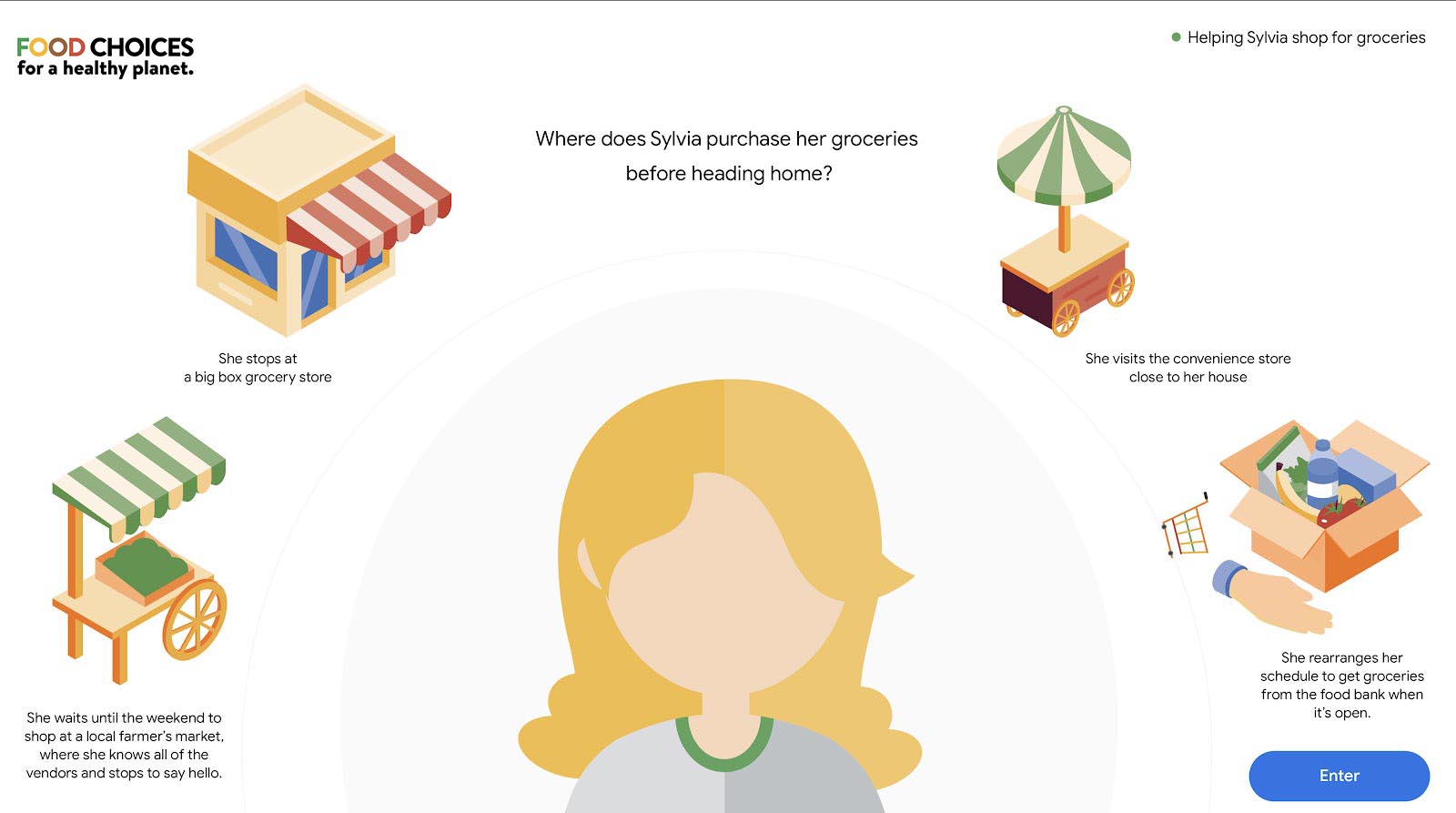

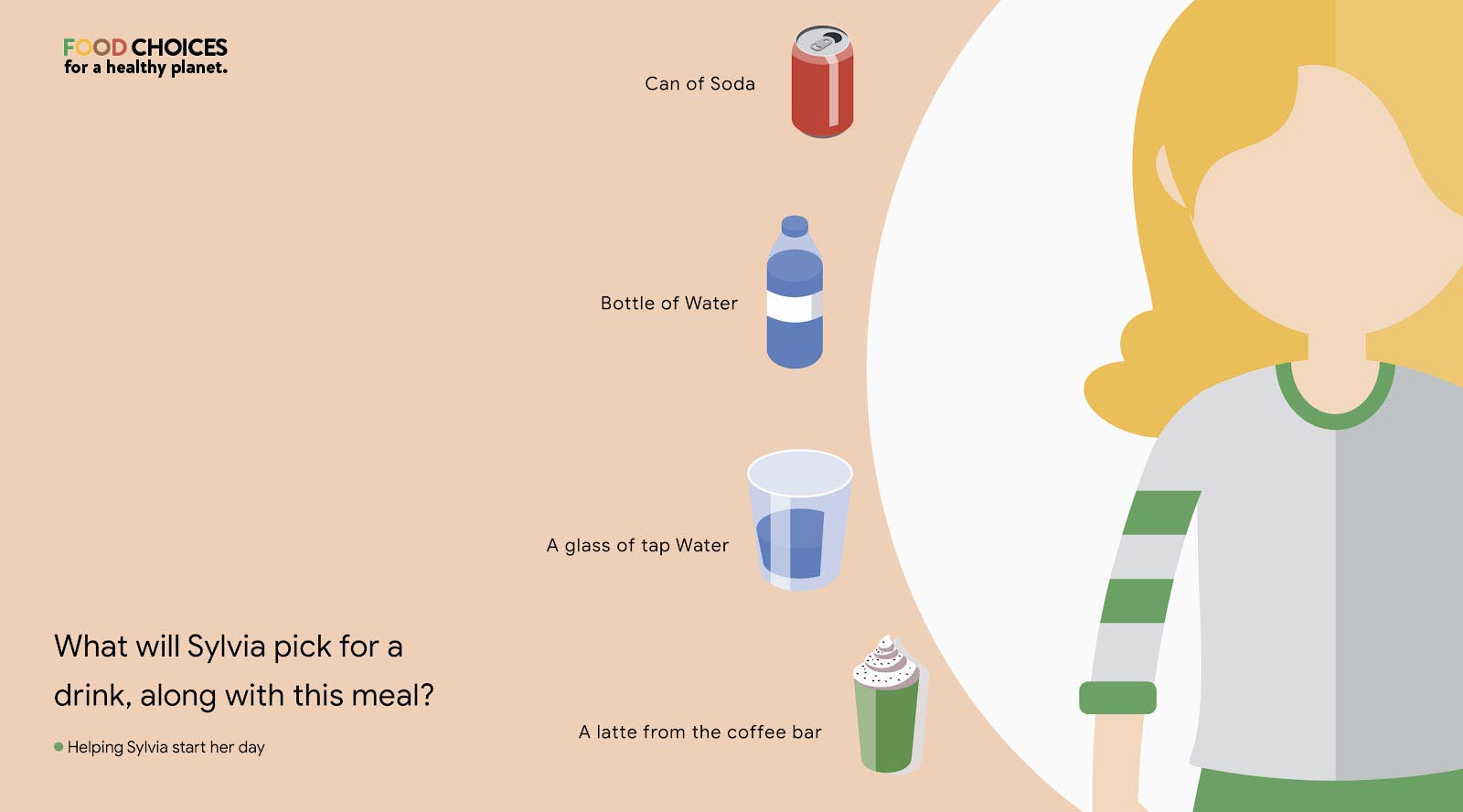
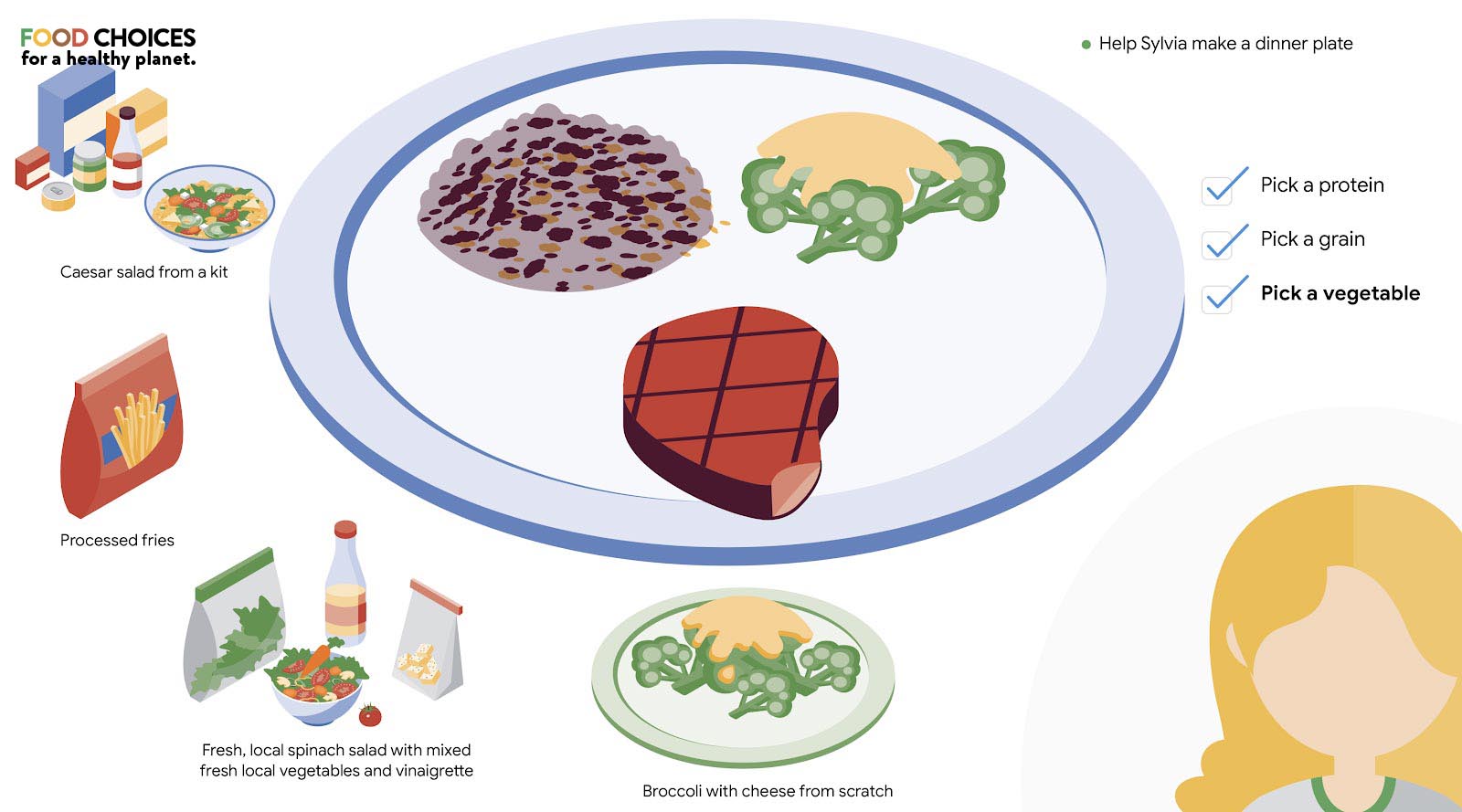
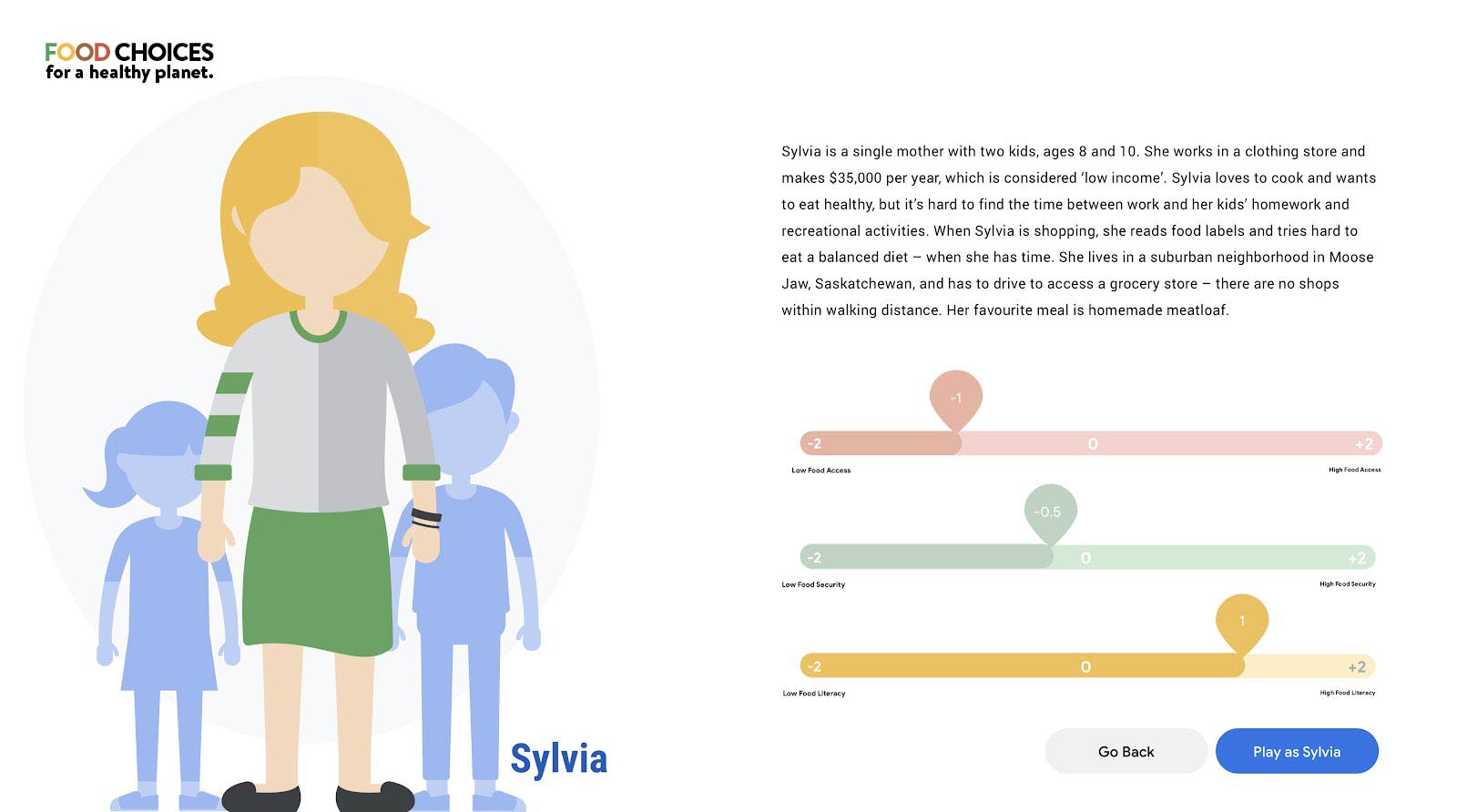
What we eat matters: at the end of each game, players learn that every decision they make impacts not only their health, but a national healthcare system, the environment, climate and even culture.
We’d love to know more about you and why you think you will be a great fit for this position! Shoot us an email introducing you and we’ll get back to you as soon as possible!
Providing best water quality conditions to ensure optimal living condition for growth, breeding and other physiological needs
Water quality is sourced from natural seawater with dependency on the tidal system. Water is treated to adjust pH and alkalinity before stocking.
Producers that own and manages the farm operating under small-scale farming model with limited input, investment which leads to low to medium production yield
All 1,149 of our farmers in both regencies are smallholder farmers who operate with low stocking density, traditional ponds, and no use of any other intensification technology.
Safe working conditions — cleanliness, lighting, equipment, paid overtime, hazard safety, etc. — happen when businesses conduct workplace safety audits and invest in the wellbeing of their employees
Company ensure implementation of safe working conditions by applying representative of workers to health and safety and conduct regular health and safety training. The practices are proven by ASIC standards’ implementation
Implementation of farming operations, management and trading that impact positively to community wellbeing and sustainable better way of living
The company works with local stakeholders and local governments to create support for farmers and the farming community in increasing resilience. Our farming community is empowered by local stakeholders continuously to maintain a long generation of farmers.
Freezing seafood rapidly when it is at peak freshness to ensure a higher quality and longer lasting product
Our harvests are immediately frozen with ice flakes in layers in cool boxes. Boxes are equipped with paper records and coding for traceability. We ensure that our harvests are processed with the utmost care at <-18 degrees Celsius.
Sourcing plant based ingredients, like soy, from producers that do not destroy forests to increase their growing area and produce fish feed ingredients
With adjacent locations to mangroves and coastal areas, our farmers and company are committed to no deforestation at any scale. Mangrove rehabilitation and replantation are conducted every year in collaboration with local authorities. Our farms are not established in protected habitats and have not resulted from deforestation activity since the beginning of our establishment.
Implement only natural feeds grown in water for aquatic animal’s feed without use of commercial feed
Our black tiger shrimps are not fed using commercial feed. The system is zero input and depends fully on natural feed grown in the pond. Our farmers use organic fertilizer and probiotics to enhance the water quality.
Enhance biodiversity through integration of nature conservation and food production without negative impact to surrounding ecosysytem
As our practices are natural, organic, and zero input, farms coexist with surrounding biodiversity which increases the volume of polyculture and mangrove coverage area. Farmers’ groups, along with the company, conduct regular benthic assessments, river cleaning, and mangrove planting.
THE TERM “MOONSHOT” IS OFTEN USED TO DESCRIBE an initiative that goes beyond the confines of the present by transforming our greatest aspirations into reality, but the story of a moonshot isn’t that of a single rocket. In fact, the Apollo program that put Neil Armstrong on the moon was actually preceded by the Gemini program, which in a two-year span rapidly put ten rockets into space. This “accelerated” process — with a new mission nearly every 2-3 months — allowed NASA to rapidly iterate, validate their findings and learn from their mistakes. Telemetry. Propulsion. Re-entry. Each mission helped NASA build and test a new piece of the puzzle.
The program also had its fair share of creative challenges, especially at the outset, as the urgency of the task at hand required that the roadmap for getting to the moon be written in parallel with the rapid pace of Gemini missions. Through it all, the NASA teams never lost sight of their ultimate goal, and the teams finally aligned on their shared responsibilities. Within three years of Gemini’s conclusion, a man did walk on the moon.
FACT is a food systems solutions activator that assesses the current food landscape, engages with key influencers, identifies trends, surveys innovative work and creates greater visibility for ideas and practices with the potential to shift key food and agricultural paradigms.
Each activator focuses on a single moonshot; instead of producing white papers, policy briefs or peer-reviewed articles, these teams design and implement blueprints for action. At the end of each activator, their work is released to the public and open-sourced.
As with any rapid iteration process, many of our activators re-assess their initial plans and pivot to address new challenges along the way. Still, one thing has remained constant: their conviction that by working together and pooling their knowledge and resources, they can create a multiplier effect to more rapidly activate change.
Co-Founder
THE LEXICON
Vice President
Global Workplace Programs
GOOGLE
Who can enter and how selections are made.
A Greener Blue is a global call to action that is open to individuals and teams from all over the world. Below is a non-exhaustive list of subjects the initiative targets.
To apply, prospective participants will need to fill out the form on the website, by filling out each part of it. Applications left incomplete or containing information that is not complete enough will receive a low score and have less chance of being admitted to the storytelling lab.
Nonprofit organizations, communities of fishers and fish farmers and companies that are seeking a closer partnership or special support can also apply by contacting hello@thelexicon.org and interacting with the members of our team.
Special attention will be given to the section of the form regarding the stories that the applicants want to tell and the reasons for participating. All proposals for stories regarding small-scale or artisanal fishers or aquaculturists, communities of artisanal fishers or aquaculturists, and workers in different steps of the seafood value chain will be considered.
Stories should show the important role that these figures play in building a more sustainable seafood system. To help with this narrative, the initiative has identified 10 principles that define a more sustainable seafood system. These can be viewed on the initiative’s website and they state:
Seafood is sustainable when:
Proposed stories should show one or more of these principles in practice.
Applications are open from the 28th of June to the 15th of August 2022. There will be 50 selected applicants who will be granted access to The Lexicon’s Total Storytelling Lab. These 50 applicants will be asked to accept and sign a learning agreement and acceptance of participation document with which they agree to respect The Lexicon’s code of conduct.
The first part of the lab will take place online between August the 22nd and August the 26th and focus on training participants on the foundation of storytelling, supporting them to create a production plan, and aligning all of them around a shared vision.
Based on their motivation, quality of the story, geography, and participation in the online Lab, a selected group of participants will be gifted a GoPro camera offered to the program by GoPro For A Change. Participants who are selected to receive the GoPro camera will need to sign an acceptance and usage agreement.
The second part of the Storytelling Lab will consist of a production period in which each participant will be supported in the production of their own story. This period goes from August 26th to October 13th. Each participant will have the opportunity to access special mentorship from an international network of storytellers and seafood experts who will help them build their story. The Lexicon also provides editors, animators, and graphic designers to support participants with more technical skills.
The final deadline to submit the stories is the 14th of October. Participants will be able to both submit complete edited stories, or footage accompanied by a storyboard to be assembled by The Lexicon’s team.
All applicants who will exhibit conduct and behavior that is contrary to The Lexicon’s code of conduct will be automatically disqualified. This includes applicants proposing stories that openly discriminate against a social or ethnic group, advocate for a political group, incite violence against any group, or incite to commit crimes of any kind.
All submissions must be the entrant’s original work. Submissions must not infringe upon the trademark, copyright, moral rights, intellectual rights, or rights of privacy of any entity or person.
Participants will retain the copyrights to their work while also granting access to The Lexicon and the other partners of the initiative to share their contributions as part of A Greener Blue Global Storytelling Initiative.
If a potential selected applicant cannot be reached by the team of the Initiative within three (3) working days, using the contact information provided at the time of entry, or if the communication is returned as undeliverable, that potential participant shall forfeit.
Selected applicants will be granted access to an advanced Storytelling Lab taught and facilitated by Douglas Gayeton, award-winning storyteller and information architect, co-founder of The Lexicon. In this course, participants will learn new techniques that will improve their storytelling skills and be able to better communicate their work with a global audience. This skill includes (but is not limited to) how to build a production plan for a documentary, how to find and interact with subjects, and how to shoot a short documentary.
Twenty of the participants will receive a GoPro Hero 11 Digital Video and Audio Cameras by September 15, 2022. Additional participants may receive GoPro Digital Video and Audio Cameras to be announced at a later date. The recipients will be selected by advisors to the program and will be based on selection criteria (see below) on proposals by Storytelling Lab participants. The selections will keep in accordance with Lab criteria concerning geography, active participation in the Storytelling Lab and commitment to the creation of a story for the Initiative, a GoPro Camera to use to complete the storytelling lab and document their story. These recipients will be asked to sign an acceptance letter with terms of use and condition to receive the camera.
The Lexicon provides video editors, graphic designers, and animators to support the participants to complete their stories.
The submitted stories will be showcased during international and local events, starting from the closing event of the International Year of Fisheries and Aquaculture 2022 in Rome, in January 2023. The authors of the stories will be credited and may be invited to join.
Storytelling lab participation:
Applicants that will be granted access to the storytelling Lab will be evaluated based on the entries they provided in the online form, and in particular:
Applications will be evaluated by a team of 4 judges from The Lexicon, GSSI and the team of IYAFA (Selection committee).
When selecting applications, the call promoters may request additional documentation or interviews both for the purpose of verifying compliance with eligibility requirements and to facilitate proposal evaluation.
Camera recipients:
Participants to the Storytelling Lab who will be given a GoPro camera will be selected based on:
The evaluation will be carried out by a team of 4 judges from The Lexicon, GSSI and the team of IYAFA (Selection committee).
Incidental expenses and all other costs and expenses which are not specifically listed in these Official Rules but which may be associated with the acceptance, receipt and use of the Storytelling Lab and the camera are solely the responsibility of the respective participants and are not covered by The Lexicon or any of the A Greener Blue partners.
All participants who receive a Camera are required to sign an agreement allowing GoPro for a Cause, The Lexicon and GSSI to utilize the films for A Greener Blue and their promotional purposes. All participants will be required to an agreement to upload their footage into the shared drive of The Lexicon and make the stories, films and images available for The Lexicon and the promoting partners of A Greener Blue.